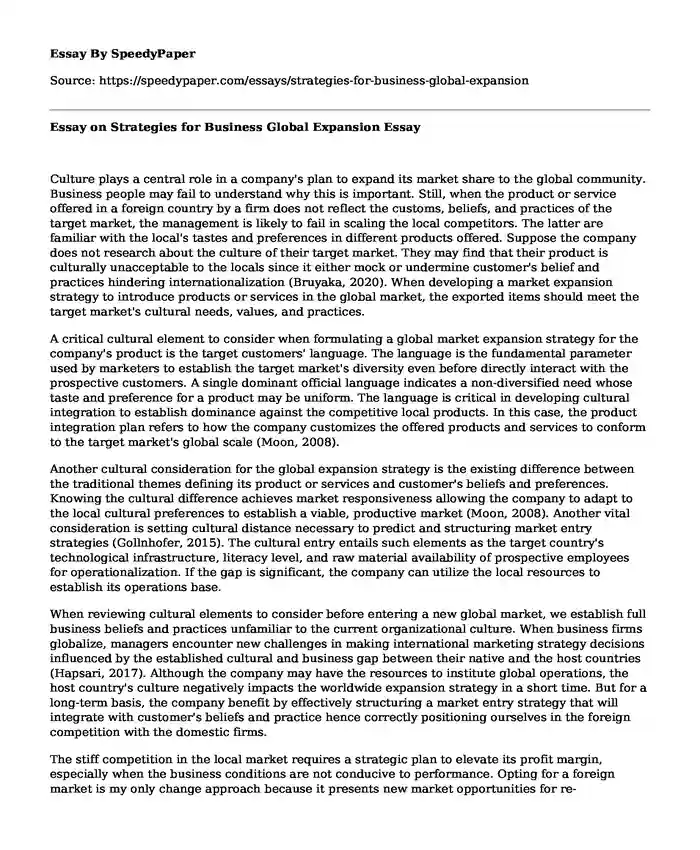
| Type of paper: | Essay |
| Categories: | Company Culture Business Strategic management |
| Pages: | 3 |
| Wordcount: | 689 words |
Culture plays a central role in a company's plan to expand its market share to the global community. Business people may fail to understand why this is important. Still, when the product or service offered in a foreign country by a firm does not reflect the customs, beliefs, and practices of the target market, the management is likely to fail in scaling the local competitors. The latter are familiar with the local's tastes and preferences in different products offered. Suppose the company does not research about the culture of their target market. They may find that their product is culturally unacceptable to the locals since it either mock or undermine customer's belief and practices hindering internationalization (Bruyaka, 2020). When developing a market expansion strategy to introduce products or services in the global market, the exported items should meet the target market's cultural needs, values, and practices.
A critical cultural element to consider when formulating a global market expansion strategy for the company's product is the target customers' language. The language is the fundamental parameter used by marketers to establish the target market's diversity even before directly interact with the prospective customers. A single dominant official language indicates a non-diversified need whose taste and preference for a product may be uniform. The language is critical in developing cultural integration to establish dominance against the competitive local products. In this case, the product integration plan refers to how the company customizes the offered products and services to conform to the target market's global scale (Moon, 2008).
Another cultural consideration for the global expansion strategy is the existing difference between the traditional themes defining its product or services and customer's beliefs and preferences. Knowing the cultural difference achieves market responsiveness allowing the company to adapt to the local cultural preferences to establish a viable, productive market (Moon, 2008). Another vital consideration is setting cultural distance necessary to predict and structuring market entry strategies (Gollnhofer, 2015). The cultural entry entails such elements as the target country's technological infrastructure, literacy level, and raw material availability of prospective employees for operationalization. If the gap is significant, the company can utilize the local resources to establish its operations base.
When reviewing cultural elements to consider before entering a new global market, we establish full business beliefs and practices unfamiliar to the current organizational culture. When business firms globalize, managers encounter new challenges in making international marketing strategy decisions influenced by the established cultural and business gap between their native and the host countries (Hapsari, 2017). Although the company may have the resources to institute global operations, the host country's culture negatively impacts the worldwide expansion strategy in a short time. But for a long-term basis, the company benefit by effectively structuring a market entry strategy that will integrate with customer's beliefs and practice hence correctly positioning ourselves in the foreign competition with the domestic firms.
The stiff competition in the local market requires a strategic plan to elevate its profit margin, especially when the business conditions are not conducive to performance. Opting for a foreign market is my only change approach because it presents new market opportunities for re-establishment and scale up its performance. Although cultural gap and distance pose a real threat to the global expansion approach, the strategy guarantees positive outcomes with enough resources and the right manager.
References
Bruyaka, O. C. (2020). International cultural ambidexterity: Balancing tensions of foreign market entry into distant and proximate cultures. Journal of Business Research, pp. 491-506. https://doi.org/10.1016/j.jbusres.2020.06.020.
Gollnhofer, J. F. (2015). Cultural distance and entry modes: Implications for global expansion strategy. Cross-Cultural Management, pp. 21-41. https://doi.org/10.1108/CCM-07-2013-0114.
Hapsari, C. J. (2017). The influence of perceived cultural and business distance on international marketing strategy decisions: A case study of Telkom Indonesia International. International Review of Marketing and Management, pp. 238-245. https://www.researchgate.net/profile/Jol_Stoffers/publication/325929622_The_Influence_of_Perceived_Cultural_and_Business_Distance_on_International_Marketing_Strategy_Decisions_A_Case_Study_of_Telkom_Indonesia_International/links/5b2cf018a6fdcc8506bdd4ec/The-Influence-of-Perceived-Cultural-and-Business-Distance-on-International-Marketing-Strategy-Decisions-A-Case-Study-of-Telkom-Indonesia-International.pdf
Moon, H.-C. M.-Y. (2008). A new framework for global expansion: A dynamic diversification-coordination (DDC) model. Management Decision, pp. 131-151. doi:10.1108/00251740810846789
Cite this page
Essay on Strategies for Business Global Expansion. (2024, Jan 14). Retrieved from https://speedypaper.net/essays/strategies-for-business-global-expansion
Request Removal
If you are the original author of this essay and no longer wish to have it published on the SpeedyPaper website, please click below to request its removal:
- Essay Sample with the Research Summary on International Business
- Free Essay Evaluating the Acquisition of Artforever.com by Neuquen Inc.
- Free Essay: Corporate Corruption in the World of Big Business
- Free Essay Sample - Food Memoir
- Marketing Final Paper - Free Essay
- Paper Example: Corporate-Level Strategy
- The Strategic Insights and Benefits of Turnkey Projects in International Business - Paper Example
Popular categories




